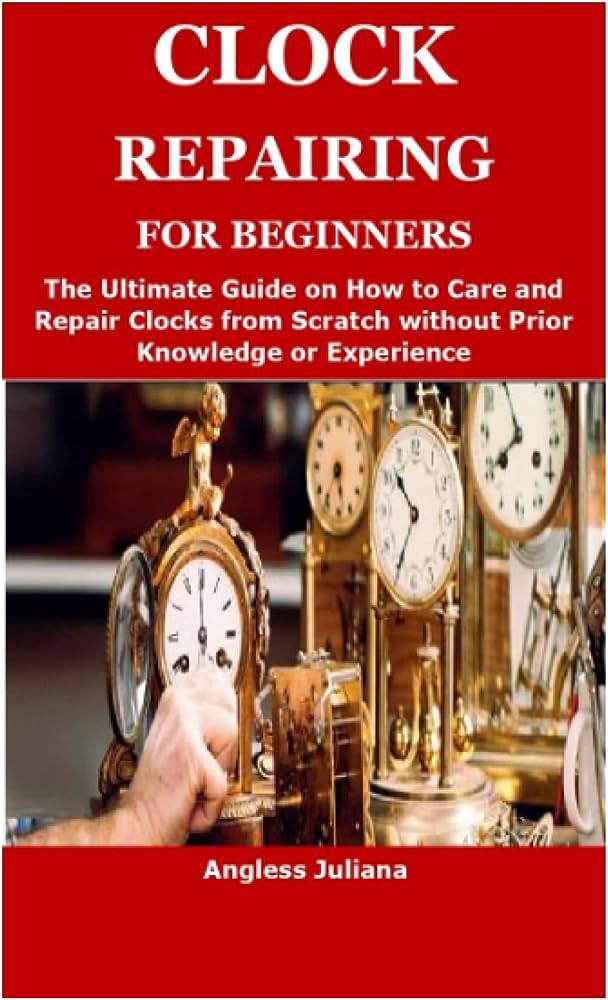Contents
- The Ultimate Guide to Clock Repair for Beginners
- Understanding the Basics of Clocks
- Essential Tools for Clock Repair
- Disassembling and Cleaning Clock Movements
- Identifying and Troubleshooting Common Clock Problems
- Repairing and Replacing Clock Hands
- Fixing and Replacing Broken Clock Pendulums
- Restoring Clock Dials and Bezels
- Maintaining and Lubricating Clock Movements
- Replacing Clock Springs and Cables
- Assembling and Testing the Clock
If you’ve ever been fascinated by the inner workings of clocks and have always wanted to learn how to repair them, then “The Ultimate Guide to Clock Repair for Beginners” is the perfect book for you. This comprehensive guide is designed to help beginners navigate the fascinating world of clock repair, covering everything from the basic tools you’ll need to the step-by-step process of repairing and restoring both mechanical and quartz clocks. With clear instructions and detailed illustrations, this book provides a solid foundation for anyone looking to start their clock repair journey. Whether you’re a hobbyist or aspiring professional, this guide is the best resource to help you gain the skills and knowledge needed to become a skilled clock repairer.
The Ultimate Guide to Clock Repair for Beginners
Welcome to the ultimate guide to clock repair for beginners! If you have always been fascinated by the intricate mechanisms of clocks and want to learn how to fix them yourself, you have come to the right place. In this comprehensive guide, we will take you through the basics of clocks, the essential tools you will need for clock repair, and step-by-step instructions on disassembling, cleaning, troubleshooting, and repairing various components of a clock. So, let’s dive into the world of clock repair and unlock the secrets of these timeless treasures!
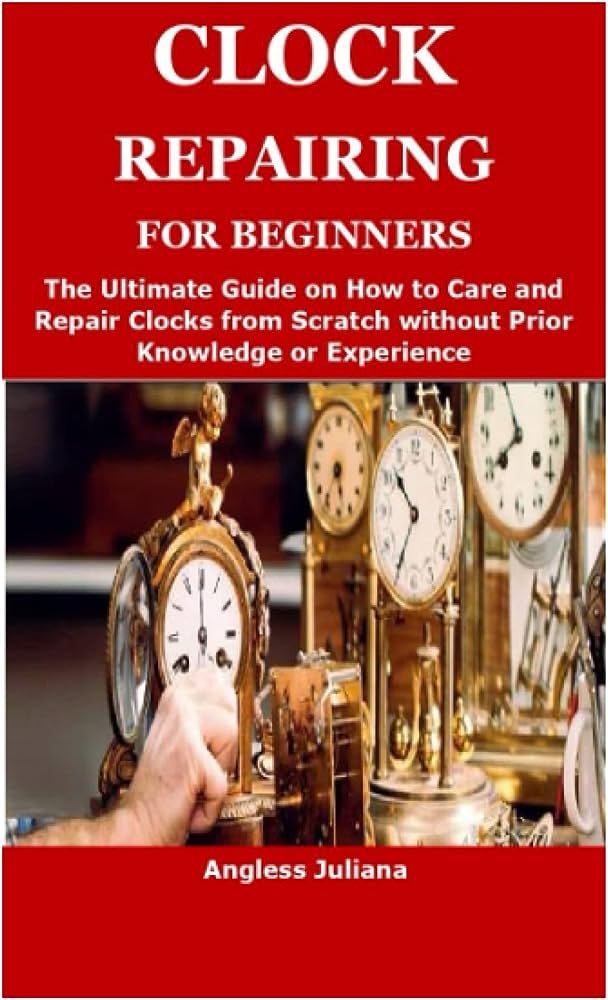
Understanding the Basics of Clocks
Before you can start repairing a clock, it is crucial to understand its basic components and how they work together. Clocks consist of several key parts, including the movement, pendulum, dial, hands, and bezel. The movement is the heart of the clock and includes gears, springs, and other mechanisms responsible for keeping time. The pendulum regulates the movement of the clock by swinging back and forth at a precise rate. The dial displays the time, while the hands indicate the hours, minutes, and sometimes seconds. The bezel protects the dial and may also include features like a glass cover or decorative elements. By familiarizing yourself with these components, you will have a solid foundation for repairing and maintaining a wide range of clocks.
Essential Tools for Clock Repair
To fix clocks effectively, you will need a set of essential tools specifically designed for clock repair. Some of the must-have tools include:
- Screwdrivers: Having a variety of screwdrivers in different sizes and types is crucial for removing screws in various parts of the clock.
- Pliers: Pliers are handy for holding, twisting, or cutting small parts, wires, or cables.
- Tweezers: Precision tweezers allow you to handle delicate components with utmost care and accuracy.
- Files: Files help in smoothing or shaping metal parts and removing burrs or rough edges.
- Cleaning supplies: Clock movements require regular cleaning. Therefore, you will need solvents, brushes, and cleaning cloths to ensure optimal performance.
- Lubricants: Proper lubrication is essential for the smooth operation of clock movements. Grease, oil, and other lubricants are necessary to keep the gears running efficiently.
- Magnifying glass: A magnifying glass will help you examine and inspect small details up close for a more accurate diagnosis and repair.
By assembling a well-stocked toolkit, you will have all the necessary instruments to tackle various clock repair tasks.
Disassembling and Cleaning Clock Movements
To keep a clock in optimal working condition, regular cleaning is essential. Over time, dust, dirt, and old lubricants can build up and affect the movement’s efficiency. Disassembling and cleaning the clock movement is a crucial step in clock repair.
Before you begin the disassembly process, make sure you have a clean and clutter-free workspace. Begin by removing the clock’s hands, carefully unscrewing them or gently prying them off with a hand remover tool. Once the hands are removed, you can access the movement.
Carefully remove the movement from the clock case, ensuring you take note of its positioning and any screws or attachments holding it in place. Once the movement is out, place it on a soft and clean cloth to protect delicate parts.
Next, use a gentle solvent or cleaning solution to remove dirt and old lubricants from the gears, springs, and other components. Use soft brushes, toothpicks, or cotton swabs to reach into narrow spaces and remove any debris. Be careful not to apply too much pressure to prevent damage.
After cleaning each component, inspect them for signs of wear or damage. Replace any worn-out or broken parts as necessary. Once all the parts are clean and in good condition, it’s time to lubricate them using the appropriate lubricants. Be sure to follow the clock manufacturer’s recommendations for the type and amount of lubrication needed.
Once the movement is cleaned and lubricated, reassemble the clock carefully, ensuring you align all the gears and springs correctly. Replace the movement back into the clock case and secure it with the necessary screws or attachments. Finally, reattach the clock hands, making sure they are positioned precisely on the dial. Congratulations! You have successfully disassembled, cleaned, and reassembled a clock movement.
Identifying and Troubleshooting Common Clock Problems
Clocks can encounter various issues that may affect their performance. Identifying and troubleshooting these problems will be essential in your clock repair journey. Here are some common clock problems and their possible solutions:
-
Clock not keeping time: If your clock is consistently running fast or slow, it may indicate an issue with the pendulum length or improper regulation. Adjust the pendulum length by adjusting the pendulum nut or regulating the clock using the regulator.
-
Clock not chiming or striking: If your clock has chime or strike functions but they are not working, check if the chime/silent lever is engaged correctly. Additionally, ensure that the chime hammers are not obstructed or misaligned. In some cases, the issue may also be related to worn-out or broken parts in the chime/strike mechanism.
-
Pendulum swinging irregularly: If the pendulum swings erratically or stops entirely, it may be due to an imbalance caused by a damaged suspension spring or bent pendulum rod. Inspect these components and replace or repair them if necessary.
-
Clock hands not moving: If the clock hands are not moving, check if they are rubbing against any obstructions or if the hour hand is caught on the minute hand. Adjust them accordingly to ensure smooth movement.
By understanding these common problems and their possible solutions, you will be well-equipped to diagnose and fix issues that may arise with various types of clocks.
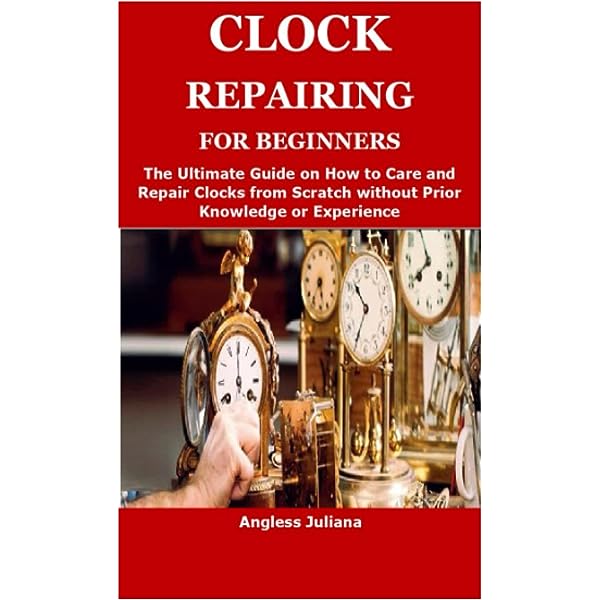
Repairing and Replacing Clock Hands
Clock hands are not only functional but also contribute to the aesthetics of a clock, enhancing its overall appearance. Over time, clock hands can become damaged or may need replacement due to wear and tear. Repairing or replacing clock hands requires some patience and precision.
If the clock hands are loose or misaligned, you can gently tighten or adjust them with a hand setter tool. However, if the clock hands are broken or damaged, they will need to be replaced. To replace the clock hands, begin by removing the old hands using a hand remover tool. Take note of their position and orientation so that the new hands can be precisely installed.
When purchasing replacement hands, ensure they are the correct size and style for your clock. Once you have the new hands, carefully position them on the clock dial, aligning them with the correct time indicated. Press them securely in place, ensuring they are not rubbing against each other or any other obstructions.
Replacing clock hands can greatly enhance the appearance of a clock and give it a fresh, renewed look.
Fixing and Replacing Broken Clock Pendulums
The pendulum is a vital component of a clock, regulating its timekeeping. However, pendulums can become damaged or broken due to accidents or mishandling. Fixing or replacing a broken clock pendulum requires attention to detail and patience.
If your clock pendulum is only slightly damaged, you may be able to repair it by straightening any bent components. Gently manipulate the bent portions back into their original position using pliers or your hands. Be careful not to apply too much force, as it could cause further damage. Once the pendulum is straightened, reattach it to the clock movement and test its swing to ensure it is functioning correctly.
However, if the pendulum is severely damaged or beyond repair, replacement is necessary. When purchasing a replacement pendulum, ensure it is the correct length and weight to maintain the proper timekeeping of your clock. Detach the old pendulum and carefully attach the new one in its place, making sure it hangs freely without any obstructions. Adjust the pendulum’s length using the pendulum nut until the clock keeps accurate time.
By fixing or replacing a broken clock pendulum, you can restore the functionality and elegance of your cherished timepiece.
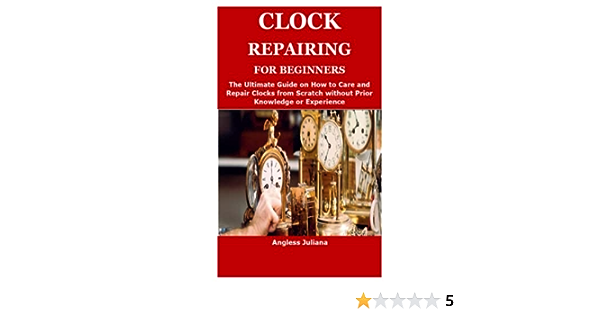
Restoring Clock Dials and Bezels
The clock dial and bezel are often the most visible and decorative parts of a clock, contributing to its overall appearance. Over time, dials and bezels may become scratched, faded, or tarnished, detracting from the clock’s beauty. Restoring clock dials and bezels can help revive their original splendor.
To restore a clock dial, begin by removing it from the clock case. Gently clean the dial using a mild soap and water solution, being careful not to damage any artwork or decorative elements. If the dial is heavily tarnished or has stubborn stains, you can use a specialized dial cleaning solution or brass cleaner. Follow the manufacturer’s instructions for the cleaning solution and take precautions to protect the surrounding areas.
For dials with painted artwork or numbers, avoid using abrasive cleaners that may erode or fade the delicate designs. Instead, use a soft cloth or cotton swab to gently remove dirt or stains. Once cleaned, allow the dial to dry completely before reattaching it to the clock case.
Similarly, bezels can be cleaned using appropriate cleaning solutions based on the material they are made of. For example, a glass bezel can be cleaned with a glass cleaner, while a metal bezel may require a metal polish. Follow the cleaning instructions provided for each specific type of material to avoid damage.
Restoring the dial and bezel of a clock will not only enhance its aesthetic appeal but also help preserve its value as a timeless piece of art.
Maintaining and Lubricating Clock Movements
Proper maintenance and lubrication are crucial to ensure the smooth and accurate functioning of clock movements. Regular lubrication can prevent friction, reduce wear and tear, and prolong the lifespan of your clock.
To maintain and lubricate clock movements, start by removing the clock hands and movement from the case. Clean the movement using a gentle solvent or clock cleaner, as mentioned earlier. Once the movement is clean, it’s time to apply lubrication.
Different parts of the clock movement require different types of lubricants. For example, gears may need a lightweight clock oil, while pivots or arbors may benefit from a specific grease. Refer to the manufacturer’s recommendations or consult a reputable clock repair guide or expert to ensure you select the appropriate lubricants for each part.
Apply the lubricants sparingly, using a fine brush or oiler to reach the necessary areas. Be careful not to apply too much oil or grease, as excess lubrication can attract dirt and cause slippage in the gears.
Once all the necessary parts are properly lubricated, reassemble the clock movement and reattach it to the case. Test the clock to ensure it is running smoothly and keeping accurate time. Regular maintenance and lubrication will help preserve the performance and longevity of your cherished timepiece.
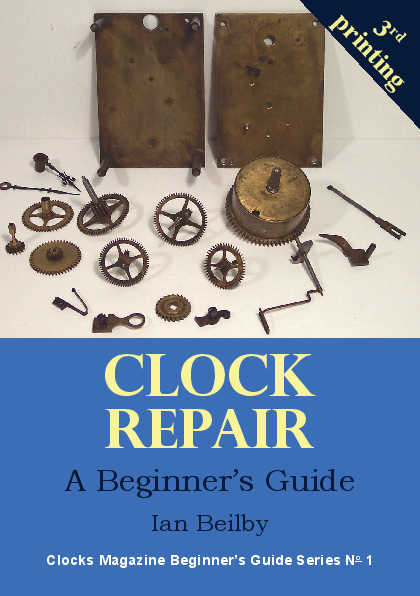
Replacing Clock Springs and Cables
Clock springs and cables are essential components responsible for the power and movement of the clock. Over time, these components may become worn-out or broken and require replacement. Replacing clock springs and cables can be challenging and may require some advanced knowledge and skills.
Before attempting to replace a clock spring or cable, it is important to study the specific mechanism and understand how it functions. Some clocks may have movements that are accessible from the front, while others require removal of the movement from the clock case to access the springs and cables. Refer to a reliable clock repair guide or seek guidance from an expert to ensure you are making the correct and safe replacement.
When replacing a clock spring, take note of its size, strength, and the number of turns required. Remove the old spring carefully, taking care not to damage any other parts in the process. Attach the new spring, ensuring it is properly wound and positioned within the movement.
Replacing cables may also be a complex task, as they need to be properly measured and cut to the appropriate length. The ends of the cable may need to be secured to the barrel or the movement using specific techniques. Pay attention to any guides or instructions provided with the replacement cables to ensure a successful and safe replacement.
Due to the complexity and potential risks involved with replacing clock springs and cables, it is advisable to seek the assistance of a professional if you are unsure or inexperienced in this area.
Assembling and Testing the Clock
After completing all the necessary repairs and replacements, it’s time to bring your clock back to life. Begin by reassembling all the components, including the movement, dial, hands, bezel, and pendulum. Ensure each part is securely attached and properly aligned.
Once the clock is fully assembled, set the time and carefully regulate the pendulum to ensure accurate timekeeping. Allow the clock to run for several hours or even a full day, monitoring its performance and checking for any irregularities. Make any necessary adjustments or fine-tuning until the clock is functioning correctly.
Congratulations! You have successfully repaired and assembled a clock, bringing it back to its former glory.
In conclusion, clock repair for beginners may seem daunting at first, but with the right tools, knowledge, and patience, it can become a rewarding and enjoyable hobby. By understanding the basics of clocks, learning the necessary repair techniques, and acquiring the essential tools, you will be well-prepared to tackle various clock repair tasks. Remember to always approach clock repair with care, precision, and a deep appreciation for the intricate world of horology. Happy repairing!


